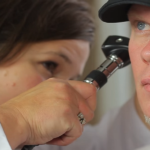DOT Exam and Heart Disease
Drivers, If you have or had any history of cardiovascular disease (heart disease), that includes angina (chest pain), myocardial infarction (MI) or heart attack, please read the following requirements when you come in for your DOT physical exam. If you’ve had any procedures for these medical conditions, including angioplasty, stents, or bypass surgery, you will need to familiarize yourself with the following FMCSA guidelines. Please share them with your treating doctor as you will need to provide us with medical records and clearance letters from your doctor. Remember, only a FMCSA approved DOT medical examiner can certify you physically and provide you with a medical examiner’s certificate. You and your company or motor carrier will have to be compliant by May 21, 2014. In the mean time, prior to that, a properly performed DOT driver physical exam by a medical examiner as defined by the FMCSA will suffice, and will be valid for the time period you are certified for, even if it extends beyond May 21, 2014. However, if you are getting your examination for the first time or re-certifying on or after May 21, 2014, you will need to see a medical examiner listed in the National Registry of Certified Medical Examiners (NRCME).
Here are the Cardiovascular guidelines (please share with your treating doctor):
Angina (chest pain)
- Minimum of 3 months with no resting angina or change in angina pattern or decreased response to medication.
- stable angina
- asymptomatic.
- tolerating medications.
- satisfactory ETT (exercise tolerate test)
- evaluation and clearance from a cardiovascular specialist who understands the functions and demands of commercial driving. Satisfactory ETT every two years. If an ETT is inconclusive, an imaging stress test may be indicated.
MI (myocardial infarction or heart attack)
*video: http://www.nlm.nih.gov/medlineplus/ency/anatomyvideos/000037.htm
- minimum 2 month waiting period post MI
- asymptomatic
- tolerating medications and cardiovascular therapy
- satisfactory ETT (post MI aprox.4-6 wks).
- Left Ventricular Ejection Fraction (LVEF) greater than or equal to 40%
- no resting ECG ischemic changes
- no angina at rest, or change in angina pattern within 3 months of examination
- satisfactory ETT every 2 years.**
- clearance by cardiovascular specialist who understands the functions and demands of commercial driving such as load/unloading cargo, tarping trailers, inspecting brake lines and putting on tire chains.
PCI (Percutaneous Coronary Intervention)
“Angioplasty with or without stents”
videos: http://www.nlm.nih.gov/medlineplus/ency/anatomyvideos/000096.htm
shorter video: http://www.nlm.nih.gov/medlineplus/ency/anatomyvideos/000008.htm
- mandatory 1 week waiting period
- asymptomatic at examination.
- tolerating medications.
- no injury to the vascular access site.
- no incomplete healing or complication at vascular access site.
- no resting angina.
- no ischemic electrocardiogram (ECG) changes.
- following initial certification to drive, the driver should have a satisfactory ETT 3 to 6 months post-percutaneous coronary intervention and bring results to a 6-month follow-up examination.
- clearance from a cardiovascular specialist who understands the functions and demands of commercial driving. Satisfactory ETT every two years. If an ETT is inconclusive, an imaging stress test may be indicated.
CABG (Coronary Artery Bypass graft)
video: http://www.nlm.nih.gov/medlineplus/ency/anatomyvideos/000065.htm
- minimum waiting period of 3 months post CABG
- healed sternum.
- LVEF greater than or equal to 40%.
- asymptomatic status with no angina
- tolerating medications, no orthostatic symptoms.
- yearly exam and clearance by cardiologist.
- no current diagnosis of coronary heart disease (CHD) or cardiovascular disease (CVD) that exhibits syncope, dyspnea, collapse, or congestive heart disease that interferes with the safe operation of a commercial motor Vehicle (CMV).
The following is required yearly beginning 5 years post CABG:
- still with no current diagnosis of CHD or CVD that exhibits syncope, dyspnea, collapse, or congestive heart disease that interferes with the safe operation of a CMV.
- responding to medication and have been advised regarding use and side effects that may interfere with operation of a CMV
- beginning 5 years post-surgery, must have a satisfactory ETT yearly. Imaging stress test if indicated. Have a LVEF equal to or greater than 40%. Recommendation that driver can safely operate a CMV.
Please refer to the FMCSA 2007 Cardiovascular Guidelines Cardiovascular_Disease_2007 Guidelines and the 2009 cardiovascular Recommendation Tables Cardiovascular_Recommendation_Tables154164339-1.143224731_2009 for more information).
*videos: From MedlinePlus. A service of the US National Library of Medicine, National Institute of Health (NIH).
Stent
For a commercial driver with a stent, the Federal Motor Carrier Safety Administration (FMCSA) provides specific criteria and requirements to assess and potentially certify them to drive, with additional conditions.
Certification Requirements and Restrictions
Initial Post-Procedure Waiting Period: After a percutaneous coronary intervention (PCI) involving stent placement, a waiting period of 1-3 months is generally recommended before considering certification. This time allows for monitoring and stabilization following the procedure.
Documentation and Evaluation:
Medical Records: The driver must provide detailed medical documentation from their cardiologist indicating successful completion of the procedure and the absence of complications.
Exercise Tolerance Test (ETT): The driver is required to undergo an ETT after the waiting period. The test must demonstrate the driver’s ability to achieve a workload of at least 6 METs (metabolic equivalents) without symptoms, ischemia, or concerning arrhythmias.
Periodic Monitoring: The driver should continue with regular follow-ups as recommended by their cardiologist, generally every 1-2 years, to monitor heart health and any developments related to stent placement.
Certification Duration:
If the driver is otherwise fit and meets all additional health and performance criteria, they may be certified for up to 1 year initially. Annual re-evaluation and re-certification are typically required to ensure that there are no complications or worsening cardiovascular conditions that might impact safe driving.
Additional Factors:
If the driver is taking medications (e.g., anticoagulants or antiplatelet therapy), the medication must not interfere with the ability to operate a commercial motor vehicle safely.
The driver should not have other disqualifying conditions such as recurrent angina, symptomatic heart disease, or uncontrolled hypertension.
Summary
According to FMCSA guidelines, a driver with a stent can be certified for up to 1 year post-PCI, assuming they have completed the waiting period, passed the ETT, and provided satisfactory medical documentation. Regular follow-up evaluations are mandatory to continue certification and ensure ongoing fitness for duty.


